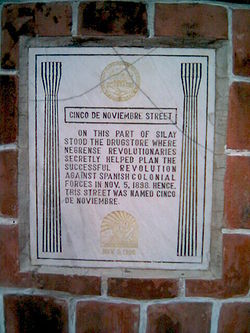This article needs additional citations for verification. (November 2017) |
| Negros Revolution of 1898 | |||||||
|---|---|---|---|---|---|---|---|
| Part of the Philippine Revolution | |||||||
 Cinco de Noviembre Memorial Marker in Silay City, Negros Occidental, Philippines | |||||||
| |||||||
| Belligerents | |||||||
| |||||||
| Commanders and leaders | |||||||
|
|
| ||||||
| Casualties and losses | |||||||
| Unknown | Unknown | ||||||
The Negros Revolution (Filipino: Himagsikang Negrense; Cebuano: Rebolusyong Negrense; Spanish: Revolución negrense), commemorated and popularly known as the Fifth of November (Spanish: Cinco de noviembre) or Negros Day (Hiligaynon: Adlaw sang Negros; Cebuano: Adlaw sa Negros; Spanish: Día de Negros), was a political movement that in 1898 created a government on Negros Island in the Philippines, ending Spanish control of the island and paving the way for a republican government run by the Negrense natives. The newly established Negros Republic (Hiligaynon: Republika sg Negros; Cebuano: Republika sa Negros; Spanish: República de Negros) lasted for approximately three months. American forces landed on the island unopposed on February 2, 1899, ending the island's independence. Negros was then annexed to the Philippine Islands on 20 April 1901.[1][2]
- ^ Zaide, Gregorio F. (1970). "Philippine Constitutional History and Constitutions of Modern Nations: With Full Texts of the Constitutions of the Philippines and Other Modern Nations".
- ^ Diamonon, Victoriano D. (1920). "The Development of Self-government in the Philippine Islands".